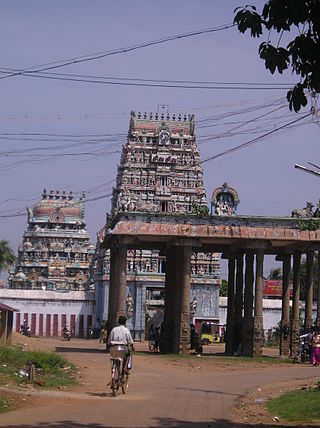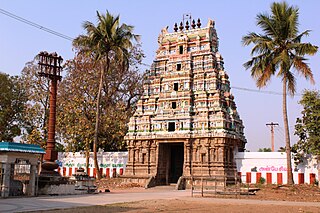
Sambandar, also referred to as Tirujnana Sambandar, was a Shaiva poet-saint of Tamil Nadu who lived sometime in the 7th century CE. According to the Tamil Shaiva tradition, he composed an oeuvre of 16,000 hymns in complex meters, of which 383 (384) hymns with 4,181 stanzas have survived. These narrate an intense loving devotion (bhakti) to the Hindu god Shiva. Sambandar died when he was sixteen years of age. The surviving compositions of the poet-saint are preserved in the first three volumes of the Tirumurai, and provide a part of the philosophical foundation of Shaiva Siddhanta.

Sundarar, also referred to as Chuntarar, Chuntaramurtti, Nampi Aruran or Tampiran Tolan, was an eighth-century poet-saint of Tamil Shaiva Siddhanta tradition of Hinduism. He is among the Tevaram trio, and one of the most prominent Nayanars, the Shaiva bhakti (devotional) poets of Tamil Nadu.

The Nellaiappar Temple is a Hindu temple dedicated to the deity Shiva, located in Tirunelveli, a city in the South Indian state of Tamil Nadu. Shiva is worshipped as Nellaiappar represented by the lingam and his consort Parvati is depicted as Kanthimathi Amman. The deity Vishnu is also worshipped here, having witnessed their wedding according to legend. Hence, this temple is regarded as an abhimana kshetram of Vaishnavism. The temple is located on the northern banks of Thamirabarani River in Tirunelveli district. The presiding deity is revered in the 7th century Tamil Saiva canonical work, the Tevaram, written by Tamil saint poets known as the nayanmars and classified as Paadal Petra Sthalam.

The Tevaram, also spelled Thevaram, denotes the first seven volumes of the twelve-volume collection Tirumurai, a Shaiva narrative of epic and Puranic heroes, as well as a hagiographic account of early Shaiva saints set in devotional poetry. The Tevaram volumes contain the works of the three most prominent Shaiva Tamil saints of the 7th and 8th centuries: Sambandar, Appar, and Sundarar. The three saints were not only involved in portraying their personal devotion to Shiva, but also engaged a community of believers through their songs. Their work is an important source for understanding the Shaiva Bhakti movement in the early medieval South India.

The Paadal Petra Sthalam, also known as Tevara Sthalam, are 276 temples that are revered in the verses of Shaiva Nayanars in the 6th-9th century CE. The Divya Desams by comparison are the 108 Vishnu temples glorified in the poems of the contemporary Vaishnava Alvars of Tamil Nadu, India.

Thyagaraja Temple is a Shiva temple, located in the town of Thiruvarur in Tamil Nadu state, India. Shiva is worshiped in the form of a lingam as Thyagarajaswami, also known as Putridankondar. His consort Parvati is worshipped as Goddess Neelotpalambika. She is also worshipped as Goddess Kamalambika, whose separate shrine is an important center for Shaktism and Tantra, and is also regarded to be one of the Shakti Peethas. The presiding deity is revered in the 7th century Shaiva canonical work, the Tevaram, written in Tamil by saint poets known as the Nayanars and the shrine is classified as a Paadal Petra Sthalam.

Mahalingeswaraswamy Temple, Thiruvidaimarudur is a Hindu temple dedicated to the deity Shiva, located in Tiruvidaimaruthur, a village in the South Indian state of Tamil Nadu. It is significant to the Hindu sect of Saivism as one of the seven major Shiva temples. Shiva is worshiped as Mahalingeswaraswamy, and is represented by the lingam, with his idol referred to as Jyothirmayalingam. His consort Mookambika is depicted as Devi Bruhatsundarakuchaambika or Bruhatsundarakuchaambigai amman. The lingam of the temple is believed to be the focal point for the seven consorts of Shiva. The presiding deity is revered in the 7th century Tamil Saiva canonical work, the Tevaram, written by Tamil poet saints known as the nayanars and classified as Paadal Petra Sthalam. The 9th century Saiva saint poet Manikkavacakar has sung praise about the temple in his works. Pattinattar, one of the revered saints visited this shrine many times.

Nageswaraswamy Temple is a Hindu temple dedicated to Shiva located in Kumbakonam in Thanjavur district, Tamil Nadu, India. The presiding deity is revered in the 7th-century Tamil Saiva canonical work, the Tevaram, written by Tamil poet saints known as the nayanars and classified as Paadal Petra Sthalam. The temple is counted as the earliest of all Chola temples. Shiva in the guise of Nagaraja, the serpent king..

Kalyanasundaresar Temple, Nallur or Thirunallur is a Hindu temple dedicated to the deity Shiva in Nallur, Tamil Nadu, India. It is located 10 km (6.2 mi) away from Kumbakonam, 6 km (3.7 mi) east of Thirukkarugavur, and 30 km (19 mi) south of Thanjavur.

Vedaranyeswarar Temple is a Hindu temple dedicated to the god Shiva, located in the town of Vedaranyam in Tamil Nadu, India. Vedaranyeswarar is revered in the 7th century Tamil Shaiva canonical work, the Tevaram, written by Tamil saint poets known as the Nayanars and classified as Paadal Petra Sthalam. It is the only temple to have found mention in all the seven Thirumurais. The temple is famed for the legend between the saints Appar and Sambandar when the former sang to open the door while the latter sang to close the door.

The Masilamaniswara Temple, Thirumullaivoyal or Masilamaniswara Temple is a Hindu temple dedicated to Shiva located in Thirumullaivoyal in the Chennai-Avadi road, India. The temple is incarnated by the hymns of Tevaram and is classified as Paadal Petra Sthalam. The temple is incarnated by the hymns of Sundarar, Ramalinga Swamigal and Arunagirinathar. His consort Parvati is depicted as Piraisoodi Amman. The presiding deity is revered in the 7th-century Tamil Shaiva canonical work, the Tevaram, written by Tamil saint poets known as the nayanars and classified as Paadal Petra Sthalam.

Tirunallar Saniswaran Temple or Dharbaranyeswarar Temple is a Hindu temple dedicated to the deity Shiva, located in the Thirunallar village, in Karaikal district of Union territory of Puducherry.
Brahmapureeswarar Temple or Thiurkolili is a Hindu temple dedicated to Shiva located in Thirukkuvalai in Nagapattinam district of Tamil Nadu, India. Shiva is worshiped as Brahmapureeswarar, and is represented by the lingam and his consort Parvati is depicted as Vandamar Poonguzhali. The presiding deity is revered in the 7th century Tamil Saiva canonical work, the Tevaram, written by Tamil poet saints known as the nayanars and classified as Paadal Petra Sthalam.

Kannayariamudayar Temple, Thirukkarayil is a Hindu temple dedicated to Shiva located in Thirukaravasal in Nagapattinam district of Tamil Nadu, India. Constructed in the Dravidian style of architecture, the temple is believed to have been built during the Cholas period in the 9th century. Shiva is worshipped as Kannayiranathar and his consort Parvathi as Kailasanayaki.

Padikasu Nathar Temple is a Hindu temple located at Azhagaputhur, a village in the Thanjavur district of Tamil Nadu, India. Shiva is worshiped as Padikasunathar, and is represented by the lingam. His consort Parvati is depicted as Soundaranayagi. The presiding deity is revered in the 7th century Tamil Saiva canonical work, the Tevaram, written by Tamil saint poets known as the nayanars and classified as Paadal Petra Sthalam. The 8th century Saiva saint poet Sundarar has sung praise about the temple in his works.

Kuzhagar Temple or Kodi Kuzhagar Temple is a Hindu temple dedicated to Shiva, located in the town of Kodikkarai in Tamil Nadu, India. Kuzhagar is revered in the 7th century Tamil Saiva canonical work, the Tevaram, written by Tamil saint poets known as the nayanars and classified as Paadal Petra Sthalam.

Metraleeswarar Temple is a Hindu temple dedicated to Shiva, located in Pillaiyar Palayam area in Kanchipuram, Kanchipuram district in Tamil Nadu, India. Metraleeswarar is revered in the 7th-century CE Tamil Saiva canonical work, the Tevaram, written by Tamil saint poets known as the nayanars and classified as Paadal Petra Sthalam, the 275 temples revered in the canon. The temple is believed to have expanded during the 13th century by Later Cholas as indicated in the inscriptions.

Kachabeswarar Temple, Thirukachur is a Hindu temple dedicated to the deity Shiva, located in Thirukachur, a village in Kanchipuram district in the South Indian state of Tamil Nadu. Shiva is worshipped as Kachabeswarar, and is represented by the lingam. His consort Parvati is depicted as Antanatchi and Kanniyumaiyal. The presiding deity is revered in the 7th-century CE Tamil Saiva canonical work, the Tevaram, written by Tamil saint poets known as the Nayanars and classified as Paadal Petra Sthalam. The temple is counted as a twin temple along with Marundeeswarar Temple located in the same village.

Bhaktajaneswarar Temple is a Hindu temple dedicated to the deity Shiva, located in Thirunavalur, a village in Viluppuram district in the South Indian state of Tamil Nadu. Shiva is worshipped as Bhaktajaneswarar, and is represented by the lingam. His consort Parvati is depicted as Manonmani Amman. The temple is located on the Panruti - Kedilam road. The presiding deity is revered in the 7th century Tamil Saiva canonical work, the Tevaram, written by Tamil saint poets known as the nayanmars and classified as Paadal Petra Sthalam. The temple is closely associated with Sundarar, who is believed to have attained grace at this place.

Jalanatheeswarar Temple is a Hindu temple dedicated to the deity Shiva, located in Thakkolam, a village in Vellore district in the South Indian state of Tamil Nadu. Shiva is worshipped as Jalanatheeswarar, and is represented by the lingam. His consort Parvati is depicted as Giriraja Kannikambal. The presiding deity is revered in the 7th century Tamil Saiva canonical work, the Tevaram, written by Tamil saint poets known as the Nayanars and classified as Paadal Petra Sthalam.

























